Gayle Irwin's Blog, page 19
November 27, 2017
#givingtuesday helps animals in need
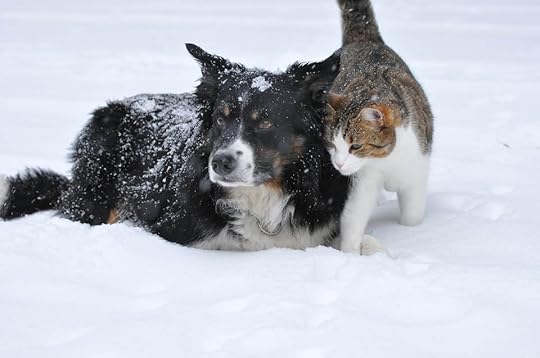 #GivingTuesday occurs this week, and on this day those of us who advocate for animals can make a big difference for those creatures.
#GivingTuesday occurs this week, and on this day those of us who advocate for animals can make a big difference for those creatures.#GivingTuesday allows us to partner with and thank non-profits around the world with a monetary donation. Around this time every year we are bombarded with spending money, from Black Friday deals to Cyber Monday savings. Many of us get wrapped up like a box at Christmas in the buy, buy, buy, and spend, spend, spend – and yes, #GivingTuesday is no exception. However, the big difference between Black Friday/Cyber Monday and #GivingTuesday is that our dollars can do a lot of good on this special day – helping charities continue their good works.
Whether your passions lie with pets or people, or both, you can make a difference on #GivingTuesday; contributing to causes that help others is a very positive endeavor, and oftentimes your donations can and will be matched through grants and other donors.
On this #GivingTuesday, if you’re an animal advocate like me, let’s pool our resources and help pets in need. Donate locally first if you believe in a pet rescue or animal shelter near you; oftentimes, the local organizations receive little to no national funding; our local groups need us, their community, to step up. But, if you want to split your donation between a local and a national group, as I often do, here are a few national animal rescue organizations you might consider supporting:Best Friends Animal Sanctuary – located in southeastern Utah, this 30+-year-old organization takes in dogs, cats, rabbits, horses, and other animals in need of rescue and re-homing; this group took in many of the Michael Vick fighting dogs and fought to save their lives – many went on to good, loving homes and did great deeds, such as served as therapy animals. Best Friends is instrumental in the No Kill movement and provides adoption centers across the country; they also partner with community shelters and rescue organizations, providing grants and other funds to help smaller groups across the country.National Mill Dog Rescue – located in Colorado Springs, Colorado, this organization, also with a long history, saves puppy mill dogs from the deplorable conditions of tiny cages and constant breeding. NMDR spends time and money socializing the dogs and providing the vet care most never received. They have saved thousands of dogs, from small to large breeds, from the horror of puppy mills.ASPCA – one of the first animal rescue organizations established in America, the American Society for the Prevention of Cruelty to Animals not only shuts down puppy mills, but responds to communities during natural disasters, such as the 2017 hurricanes and floods. They work alongside local groups to rescue and reunite, or re-home, animals affected by these events. Their primary focuses on animal homelessness and animal cruelty.American Humane – another group with a long history in the United States, this group also responds to natural disasters and cruelty cases. They are noted for the Hero Dog Awards and they also help to bring military service dogs back to the U.S. from overseas, often reuniting dogs with their military handlers.Humane Society of the United States – this organization is involved not only with pet rescue, including natural disaster response, but also works abroad with wildlife issues, such as seals and elephants. The group also tackles factory farming and animal fighting situations.
There are many wonderful organizations, including breed rescues, like English Springer Spaniel Rescue of America, Big Dogs Huge Paws (specializing in breeds such as Mastiffs and Great Danes), and Mid-America Boston Terrier Rescue (I have transported dogs for all three of these groups). If you like a specific breed of dog and want to assist a national rescue group for that breed, visit this American Kennel Club website: http://www.akc.org/dog-breeds/rescue-network/contacts/.
Another group I like to support is located in Wyoming, but its reach extends beyond state borders. Black Dog Animal Rescue, in Cheyenne, has been around for nearly 10 years, helping shelter dogs scheduled to be euthanized in shelters find new, loving adoptive homes. One of their successful programs pairs prisoners with pups; the inmates work with the dogs regarding obedience and agility training.
My plan for #GivingTuesday is to donate locally, regionally, and nationally, and though I may not have a lot of money, my contribution paired with others can, and does, make a difference.
How about you? Want to help animals in need? I hope you’ll do so on this #GivingTuesday. Animals need people and rescues and shelters need individuals and groups to help them help the animals. Show your compassion and concern today – donate and make a difference!

Published on November 27, 2017 08:14
November 21, 2017
Family Feast Can Harm Pets: Four Tips for Keeping Your Pets Safe at Thanksgiving
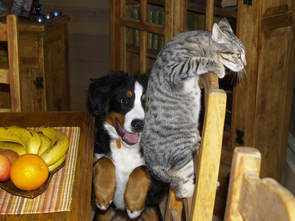 Thanksgiving is upon those of us living the United States, a time of family, friends, and feasting. However, there are many foods which are good for people but harmful to our pets. Additionally, the comings and goings of loved ones can cause stress in pets.
Thanksgiving is upon those of us living the United States, a time of family, friends, and feasting. However, there are many foods which are good for people but harmful to our pets. Additionally, the comings and goings of loved ones can cause stress in pets.Here are four tips to help keep your pets healthy and safe during this special holiday:
Keep pie, yeast dough, turkey bones and skin away from pets. Your animals can have a poisonous reaction, bloat, choke, even die if any of these human food items are consumed.Put plants and decorations out of the reach of your pets. There are many types of flowers and other plants purchased and used by people during the holiday season; some are poisonous to our dogs and cats. And, other decorations can be harmful as well. Therefore, make sure your dogs and cats cannot get to flowers, plants, and festive décor. The ASPCA website provides a list of plants and flowers that are harmful to pets. If you believe your pet has consumed something harmful, contact the Pet Poison Control Hotline immediately: (888) 426-4435Take out the trash immediately. Especially if food items are thrown out, including turkey bones, make sure the garbage is gone quickly – food smells entice dogs and cats to get into the trash; that can be not only harmful, but deadly.Keep your pet calm, safe, and indoors. The excitement of added guests to the home, the opening and closing of doors, and the presence of young children can disrupt the normal routine for your animals – after all, Thanksgiving is not just another regular day. If you have guests visiting Thanksgiving Day and your dog is excitable, loving to welcome visitors, you may need to gate off an area of your house, preventing dogs from jumping on people and from escaping out an open door. If your pet, cat or dog, is more on the shy side, having those animals inside a closed room may be beneficial, keeping them away from all the goings-on. If young children are at the gathering, there is risk of bites or scratches from your pets. Therefore, be pro-active when it comes to guests and pets, making sure each is safe (also make sure your pets are wearing ID tags and/or are micro-chipped, in case of an escape artist).
Read more pet safety tips for Thanksgiving at the following websites:
https://www.aspca.org/pet-care/general-pet-care/thanksgiving-safety-tips
https://www.avma.org/public/PetCare/Pages/thanksgiving-pet-safety.aspx
I wish you and your family, including your four-footed ones, a very happy and safe Thanksgiving!
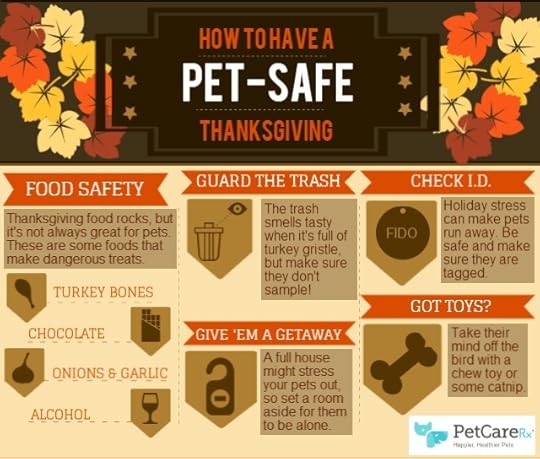
Published on November 21, 2017 03:30
November 14, 2017
5 Reasons to adopt a senior pet
 Animal shelters and rescue organizations often find difficulty in the adoption of senior pets. Our society values youth and beauty, even in animals, therefore senior pets are often overlooked when people consider adopting. However, like mature humans, senior pets offer positive life experiences and provide special companionship.
Animal shelters and rescue organizations often find difficulty in the adoption of senior pets. Our society values youth and beauty, even in animals, therefore senior pets are often overlooked when people consider adopting. However, like mature humans, senior pets offer positive life experiences and provide special companionship.The month of November is recognized as Adopt-a-Senior Pet Month, a time that animal welfare organizations promote the benefits of adopting senior pets. There are several good reasons that people should adopt mature animals.
Older pets often come housebroken/litter box trained, and, in many cases, adult dogs have some basic obedience training, knowing “sit”, “stay” and “come.” Young ones require training. Older pets expend less energy – often, a simple walk around the neighborhood for an older dog is sufficient, and mature cats enjoy lounging in the sun more than chasing strings or feathers. Therefore, if you’re not terribly active, an older pet will likely suit your lifestyle.Mature pets can be left alone for longer periods of time, primarily because they are already housetrained and way past the “chew everything in sight” stage. Therefore, you can leave older pets alone more often and trust them being in the house.When you adopt an adult, what you see is what you get. Adopting a mature pet allows you to know its size and temperament, whereas obtaining a puppy or kitten can be a guessing game when trying to determine the animal’s ultimate temperament and size.Adopting an older pet is truly a selfless act. As an animal ages, its chances of adoption grow slimmer. By giving a mature pet a home, you’re showing great compassion and empathy – and likely saving a life and gaining a wonderful furry friend in the process!
In 2008, my husband and I adopted a 10-year-old cocker spaniel that had been used for breeding then then tossed away. We hesitated about adopting him, but we love spaniels, and recognizing his chances of being adopted were not great due to his age, we decided to bring him home and grant him his last few years with a loving family. That dog lived to be nearly 18 years of age! I think in part because we gave him a secure, devoted home, but also because he had a buddy with whom to share life.
In 2013, we again adopted after the passing of our 12-year-old springer spaniel (the cocker, Cody, was still with us and was nearly 15). Cody needed a pal and we needed another companion, recognizing Cody’s ever-increasing age. Therefore, we adopted Mary, a springer/cocker mix; she was nearly 7 years old at the time. We wondered if the 8-year-age difference might be a detriment, but, because of Mary’s low-key, sweet demeanor, the two got along very well, and I believe she enhanced the last 2+ years of Cody’s life, even likely extending his life. Because of her older age, Mary’s personality and size were already in place – there was no guessing. She has been a wonderful addition to our family, devoted, kind, friendly, and sweet, and she helped us cope with Cody’s passing in early 2016.
Some people think if an older dog or cat is in the shelter there must be something wrong with it – not so! Many senior pets are relinquished because the owner can no longer care for them due to the person’s health or even death of the owner. Some of the most wonderful companion animals in need of new homes await another chance to shower a family or individual with devotion and affection, just as they did with their previous owner.
Consider adopting an older pet next time you’re looking for another furry companion. You may ultimately be saving a life – and enriching your own!

Published on November 14, 2017 05:00
November 8, 2017
businesses and individuals come together to help pets in need
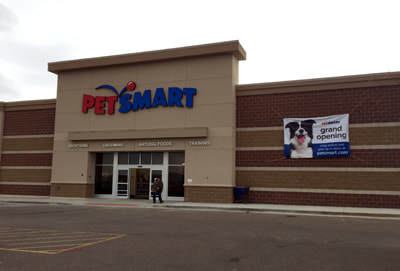 Recently, PetSmart came to my community of Casper, Wyoming, the first in the state. I have shopped this big box store for pet supplies in many other towns, enjoying the vast array of food, toy, and treat selections for my animals. Therefore, I was happy to see PetSmart open in my community.
Recently, PetSmart came to my community of Casper, Wyoming, the first in the state. I have shopped this big box store for pet supplies in many other towns, enjoying the vast array of food, toy, and treat selections for my animals. Therefore, I was happy to see PetSmart open in my community.I attended the grand opening, as did many others. How wonderful to see the long lines of pet owners and their beloved animals and to visit with the local rescue groups with which the Casper PetSmart is partnering: cats on one side of the building brought in by Temporary Home Animal Rescue (they rescue cats from Metro, our town’s kill-shelter) and dogs from Black Dog Animal Rescue on the other side of the new store. Our town already had a PetCo, which has been part of the community for several years. I have shopped there also. One of the reasons I shop these stores is not just because of the great varieties of food, toys, and treats, but also because each store has a foundation that supports pet rescue and adoption. Unlike other big-box pet stores, PetCo and PetSmart do not sell dogs, cats, puppies or kittens – they promote adoption and partner with local groups that rescue, spay/neuter, and adopt. This helps in many ways: (1) helps decrease the number of puppy/kitten mills; (2) keeps pet overpopulation/breeding at bay; (3) promotes pet adoption.
The foundations of each of these stores assists rescues and shelters in many ways. PetSmart Charities, for example, promotes pet adoptions and spay/neuter, to save lives. Nearly three million dogs and cats are killed in shelters every year. Through PetSmart stores and the Charities program, adoption events are held several weekends every year; in fact, one is planned for this weekend (check the closest PetSmart store near you). The PetCo Foundation also supports and promotes pet adoption events; the organization also raises awareness about and contributes to finding a cure for cancer in pets. And, both organizations/businesses support disaster relief regarding displaced pets. These are reasons I am happy PetSmart and PetCo are in my community. I like supporting small businesses also; however, the impact of these larger stores not only helps the homeless animals in my town, but also reaches beyond my community, helping animals in need across the country.
Another wonderful organization is Petfinder.com – not only can a person find a new furry friend via the group’s online search of shelters and rescues, but they provide wonderful resources on pet care. Petfinder also has a foundation, the mission of which is to “help ensure that no adoptable pet is euthanized for lack of a good home.” The group also helps in times of natural disaster, including the recent raving wildfires that took place in California.
As I wrote in a blog post last year about “it takes a digital village” to reunite pets, it takes a village to help pets in general. People who work in animal shelters, volunteer or staff rescues, individuals who adopt and donate, and businesses and organizations who partner with those shelters and rescues, and those who donate and/or purchase through those organizations and businesses (like PetCo/Foundation, PetSmart/Charities, and Petfinder/Foundation) – we all work together to help pets in need. Whether they are in need of new homes, of shelter from storms, or medical attention from abuse or disaster, we, as individuals, groups, organizations, and businesses, work together for the betterment of animals.
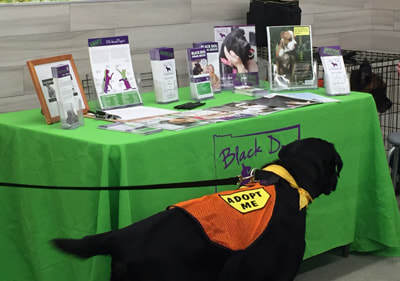
Published on November 08, 2017 08:52
November 1, 2017
How Different Types of Service Dogs Can Improve someone's Daily Life
 Animals are heroes; they impact people’s lives. Last week the Hero Dog Awards were presented by the American Humane Association and broadcast on the Hallmark Channel. These seven dogs all impact people, whether through their law enforcement or military service, bringing smiles to people in hospitals and nursing homes, or simply through their tenacious spirit after a time of abuse – dogs inspire us, if we let them.
Animals are heroes; they impact people’s lives. Last week the Hero Dog Awards were presented by the American Humane Association and broadcast on the Hallmark Channel. These seven dogs all impact people, whether through their law enforcement or military service, bringing smiles to people in hospitals and nursing homes, or simply through their tenacious spirit after a time of abuse – dogs inspire us, if we let them.I recently wrote post about Animal Heroes. This week, I’m pleased to present a guest blogger who will showcase some types of hero dogs, particularly service dogs who help people with various afflictions. For years, I’ve admired organizations who help people in need of service dogs, groups like Canine Companions for Independence, located in Santa Rosa, California, a community devastated by recent wildfires (thankfully, CCI’s facilities and dogs survived that inferno). I hope you enjoy Paige’s article regarding service dogs and the assistance they provide people – these types of dogs are truly heroes!
**********************************************************************************
Guest Post by Paige Johnson
There are vast types of service dogs, including severe allergy alert dogs, autism assistance dogs, mobility support dogs, diabetic alert dogs, medical assistance dogs, emotional support dogs, psychiatric service dogs, and more. These distinctions can be broken down into three major categories: mental illnesses, permanent mental disabilities, and physical conditions that require assistance. The Great Danes from Service Dog Project, Inc., for example, are for mobility. You would be amazed by what this can do for someone who might become stuck behind a 6-inch curb.
This article will touch on each of the above-mentioned major categories, and how having a service dog can significantly improve day-to-day life for people with such conditions.
Physical Conditions
Perhaps the most complex of the three categories are service dogs that aid physical conditions such as mobility support, allergy alert, medical assistance, and seizure response. These dogs require a substantial amount of training, as outlined by Paws Training Centers. It can take years to fully prepare a dog for the complexities of physical support. Each situation is different. For this reason, training regimens vary greatly.
Common skills include the ability to notice people approaching, to respond to a name, recognize specific sounds or smells (such as detecting low blood sugar levels), seek help from others, press a medical button, wake up an owner or retrieve personal items. Physical support dogs should be able to apply pressure, cuddle on cue, respond to anxiety or panic attacks, and interrupt nightmares or night terrors caused by PTSD (Post Traumatic Stress Disorder). As you can probably tell, physical support dogs accept a great deal of responsibility for the health and well-being of their owners. They are, quite literally, life-saving animals. Therefore, when you notice a support dog in public, you should never approach without asking first. These dogs are trained to detect danger and could perceive you as a threat, and they are working, caring for their special person. Physical support dogs are far from pets. They are considered companions and dogs with a job.
Mental Illnesses
People with issues such as panic disorder, general anxiety disorder, and depression are aided by emotional support dogs. These dogs require little or no training. They can live in all rented spaces, much like other support dogs. However, they are not always allowed in public places. This is because any pet can be considered an emotional support animal. You can register guinea pigs, cats, dogs, rabbits, or ferrets. If you feel comforted in the presence of your pet, you can register him or her as a support animal. Most non-pet apartment complexes will ask for a record of your counseling or mental diagnosis to ensure that you aren’t taking advantage of the system.
If you choose to get a service dog for your mental illness, understand the difference between a physical and emotional support dog. Should you decide to bring your dog to public spaces as though he or she is a physical support animal, it is your responsibility to provide training. Learn more about access and legal issues through Nolo.
It’s also worth noting that many people who are in recovery from substance abuse addiction find that companion animals are great options for support when managing sobriety and navigating through the difficult aspects of recovery. Animals used in this aspect, while offering emotional support, are not eligible for registration as a support animal, but they still provide ample comfort at home.
Not sure if you need an emotional support dog for your anxiety or mental illness? Anxiety Guru can help you make an informed decision.
Permanent Mental Disabilities
Our final category involves permanent mental disabilities such as autism. Called Autism Support Dogs, these animals are somewhere between physical and emotional service dogs. They do, in fact, require training. They are also respected in public areas as a physical support dog. Their job is to calm and ground an individual through deep pressure or tactile stimulation. They may also help teach important life skills. There is special bond between children and dogs, and those youngsters (as well as teens and adults) paired with such service dogs can see improvements in their lives and therefore, also in their loved ones.
All three categories of service dogs can improve your daily life by making you smile, helping you accomplish otherwise impossible physical feats, or comforting you when you need it most. Remember though there are laws against “faking” a service dog, and those people who really need a service animal can be affected by others who decide to try to by-pass the rules about housing or traveling with a dog. True service dogs are vital companions and often life-saving ones for people with various mental and physical issues.
Whether in need of a service dog or not, consider adopting from breed-specific rescues or animal welfare shelters and getting involved in the Canine Good Citizen Program, which is considered the “gold standard” for dog behavior.
Author Bio
Paige Johnson is a fitness nerd and animal lover. She shares her insights on LearnFit. She loves offering advice on a variety of topics. As a personal trainer, she has a passion for fitness training and enjoys sharing her knowledge with those seeking to live a healthier lifestyle. She's also mom to three dogs, all rescues, and volunteers at her local animal shelter. Through her time with her own pups and working at the shelter, she's picked up some great tips on pet care and training.
Photos from Pixabay.com
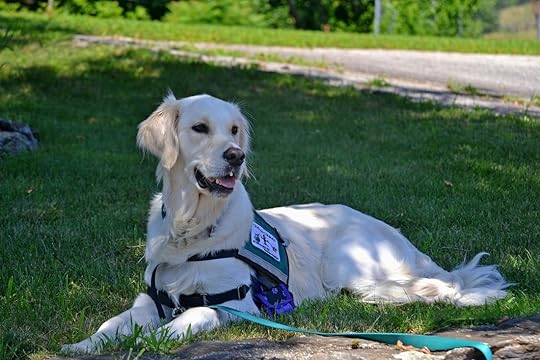
Published on November 01, 2017 05:00
October 24, 2017
don't let your pets get spooked: halloween safety tips
 October is drawing to a close, and that means Halloween is on the horizon. While most kids, and many adults, enjoy this time of year, our pets can become agitated, frightened, even lost.
October is drawing to a close, and that means Halloween is on the horizon. While most kids, and many adults, enjoy this time of year, our pets can become agitated, frightened, even lost.Here are a few safety tips to help your pets during the next few weeks:
Keep pets calm – there is a tremendous amount of activity during Halloween; that alone can stress out our pets, and sometimes costumed people can frighten them. Perhaps putting your pet(s) in a comfortable room, having your animal(s) wear a Thundershirt, or having soothing music (instead of loud, scary tunes) play are some avenues you can explore to keep your pet calm during this time.Ensure your pets are safe – make sure collar and tags are on your pet and/or that your animal has a microchip in case it slips out the door. Opening and closing doors while handing out candy can cause your pet to escape; therefore, to ensure its safe return, make sure your pet’s ID tag and/or microchip is up-to-date with your current address and phone number.Don’t let your pets eat the treats – candy and other goodies obtained from your children’s trick-or-treat bags (or left over from your handouts to neighborhood children) can be harmful to your pets. Make sure all Halloween people yummies are out of your pets’ reach.Keep lit jack-o-lanterns out of reach – not only should you keep candy out of your pets’ reach, but also keep lit jack-o-lanterns away from your pets also. A tipped-over pumpkin that’s lit can easily start a fire.Costumes can be spooky, both to see and to wear – Not only can the flurry of activity during Halloween be spooky to pets, but so also can be costumes worn. If you want your pet dressed for Halloween, don’t wait for the last minute to find out such attire scares your animal(s); try costumes on before Halloween (like this week). The ASCPA recommends if you do dress your pet for the big night, “make sure the costume does not limit his or her movement, sight or ability to breathe, bark or meow. Check the costume carefully for small, dangling or easily chewed-off pieces that could present a choking hazard.”
If you decide to dress up your pet for Halloween and have the time to create a costume, here’s a link to a cute DIY strawberry costume, complete with instructions: https://www.berries.com/blog/strawberry-costume-diy#dog.
I once dressed Cody, my cocker spaniel, as a fireman – I thought he looked cute, but he didn’t seem very impressed with the idea!
For additional Halloween pet safety tips, visit http://www.petmd.com/dog/seasonal/evr_multi_halloween_safety_tips.
May you, your children, and your pets enjoy a safe, stress-free Halloween!

Published on October 24, 2017 05:00
October 17, 2017
adopt-a-shelter-dog month, part 2: introducing your new dog to other pets
 As mentioned in last week’s blog, October is National Adopt-a-Shelter-Dog Month. Whether you adopt a dog this month or sometime in the future, knowing how best to introduce a new friend to your household if you already have pets is a helpful process for everyone involved.
As mentioned in last week’s blog, October is National Adopt-a-Shelter-Dog Month. Whether you adopt a dog this month or sometime in the future, knowing how best to introduce a new friend to your household if you already have pets is a helpful process for everyone involved.Here are a few tips for introducing a newly-adopted dog to other pets:
Give the animals currently living in your home opportunity to meet the new four-footed housemate on neutral ground. Most animal shelters provide visiting rooms to which you can bring your current pets to meet their potential new companion. A park also works very well. Meeting on neutral territory keeps your current pet from feeling the need to “protect” its territory from the “intruder;” the park meeting may seem more like a “play date” for your current dog, and if your current animal is generally friendly with other dogs, that positive park meet-up may translate well when both dogs are at your home.
When adding a new dog to your household, consider the pack mentality and the animals’ personalities. Often, it’s best to bring in a dog that is not an alpha or dominant dog; two sub-alphas are likely to get along better and even bond more strongly than a dominate and a submissive. The best pairing is usually a male and a female together (spayed and neutered of course!); two females or two males can be more aggressive toward each other, even if they’re fixed (that’s not always the case, as I have friends who have two males, they even had a third at one time, so truly, all depends on the animals’ personalities). The likelihood of assertive or aggressive behavior is often lessened when a spayed female and a neutered male live in the same household. Whenever I’ve had two dogs living in my house, I’ve always had a male and a female (fixed, of course), and that arrangement/pairing has worked out well each time, including my latest adoption which happened last month. Learn more about dog pack hierarchy from Cesar Millan at his website: https://www.cesarsway.com/dog-psychology/pack/Dog-pack-hierarchy.
Make sure there is a special, secure spot for both the new and current dog (or cat) to get away. A quiet room or a corner of your bedroom or home office can serve as that special place. A crate/kennel is often a good idea. The kennel, with the door open so that your dog can come and go as it pleases, provides security when the dog needs down time. Your newly-adopted pet, especially, needs a place to retreat to when the excitement of the day becomes too much. When our new dog, Jeremiah, came to live with us, our cats stayed in the basement for several days, even weeks, as they adjusted to the new dog in their house. We’ve not had an issue with Jeremiah chasing the cats, but we were prepared to deal with that if it became a problem, for we have experienced that in years past.
Implementing these ideas can help make your next dog adoption story a much more happily ever after! For additional tips on this topic visit the following websites:
https://bestfriends.org/resources/introducing-dogs-each-other
https://www.cesarsway.com/dog-training/socialization/a-new-member-of-the-pack
http://www.littlebuddies.org/intorducingnewpet.htm
 Mary, adopted in 2013, and Jeremiah, adopted in Sept. 2017.
Mary, adopted in 2013, and Jeremiah, adopted in Sept. 2017.
Published on October 17, 2017 05:00
October 10, 2017
adopt-a-shelter-dog month - part 1: adoption
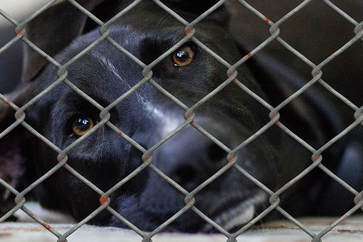 Adding a pet to one’s home can be a scary process. Many concerns can traverse one’s mind, such as “Will the animal adjust to my home?” and, if you already have pets, “Will the current pets I have adjust to the new one?” Yet, adoption is also a joyful experience, especially knowing you’ve saved a life (or two) and that you’ve given a loving home to an animal that may never have known what that means.
Adding a pet to one’s home can be a scary process. Many concerns can traverse one’s mind, such as “Will the animal adjust to my home?” and, if you already have pets, “Will the current pets I have adjust to the new one?” Yet, adoption is also a joyful experience, especially knowing you’ve saved a life (or two) and that you’ve given a loving home to an animal that may never have known what that means.October is National-Adopt-a-Shelter Dog Month, a time when many animal shelters and rescues promote the positives of dog adoption. According to Helping Hands Humane Society in Kansas, some of the benefits of adopting a shelter or rescue dog include:You can choose from various breeds and ages – rescues and shelters take in different breeds and ages of animals, and some help specific breeds (such as Big Dogs Huge Paws in Colorado, which rescues the large breeds, such as Mastiffs, Newfoundlands, and Great Danes, or Rocky Mountain Cocker Rescue, or Wyoming Basset Hound Rescue, which rescues both bassets and bloodhounds). So, whether you know the breed and age you want, or if you’re just looking for what animal best fits your home life, you have a choice.You support a valuable community charity – your adoption fee helps care for the pet you’re adopting as well as others in the care of rescue/shelter workers who provide an important community service.You save a life – actually, you save two lives, the dog you adopt and the one waiting to come into the shelter/rescue.
You help stop cruelty of mass breeding facilities – some rescues, including National Mill Dog Rescue of Colorado Springs, specifically take in dogs that have been used for breeding and basically have no social skills and have been kept in cages, not treated as members of a loving, compassionate family. Mill Dog Rescue was recently featured on the Animal Planet Program Dr. Jeff: Rocky Mountain Vet.
There are many other reasons for adopting a shelter or rescue dog. My husband and I recently adopted a Shih Tzu from Hearts United for Animals, a Nebraska rescue that also specializes in rescuing puppy mill dogs. His name was Stormy (we’ve changed it to “Jeremiah”), and he was used for breeding purposes. His lack of compassionate care resulted in 28 teeth having to be pulled. He also needed neutering, which HUA did, and to be put on a healthy diet. The little guy has settled in quite well into my household; he is a very sweet, fun boy! He gets along wonderfully with our 2013 adopted springer/cocker mix, Mary; Jeremiah is her little shadow. When we were all outside a few days ago, Jeremiah raced through the backyard, his black ears winged back, his face skyward as if in thankfulness, my heart leaped for joy as my newly-adopted dog experienced the freedom and joy of running, playing, and basking in autumn’s sunshine. This is why rescues do what they do and why pet adopters like me do what we do – give an animal a second chance at life.
According to the ASPCA, more than three million dogs enter animal shelters every year; of those, nearly 700,000 are euthanized due to lack of homes as well as medical and behavior issues. There are numerous animal shelters and pet rescue groups across the country. In my state alone (Wyoming), there are 34 listed in Petfinder.com, a wonderful resource to find your next furry friend. In fact, Petfinder lists more than 270,000 adoptable animals from more than 11,000 animal welfare organizations across America.
Will you consider adopting a dog in need of a loving home this month? Dogs like Jeremiah are just waiting for a loving, forever home. You can save lives through adoption – believe me, there’s no greater feeling in the world than to see a dog (or cat) that’s been abandoned, neglected, or left in a shelter or rescue for another reason come out of its shell and lavish the adoptive “parent” with love and devotion!
Find your next furry friend at your local shelter or rescue, or via Petfinder.com, which by the way, is how we found Jeremiah!

Published on October 10, 2017 04:30
October 4, 2017
The Comfort of Pets
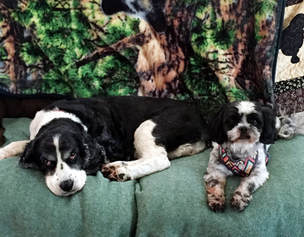 I was down for the count for a few days – scratchy throat, sinus congestion, and cough. Although I was ill, I found great comfort – in my pets.
I was down for the count for a few days – scratchy throat, sinus congestion, and cough. Although I was ill, I found great comfort – in my pets.Our newly-adopted dog, Jeremiah, stayed by my side as I napped or simply sat in the couch recliner. Mary also remained nearby, and my long-haired tuxedo cat, Murphy, lay on the arm of the couch several times. The comfort I received from their nearness and from petting them is indescribable. Many of you can relate to that. Our pets can be our therapy, no matter if we’re suffering from a physical illness or from emotional turmoil.
Therapy animals provide great comfort to people. Dogs, cats, guinea pigs, even horses and small ponies provide respite for humans in hospitals, hospice, or other settings. Through specific training, these animals are welcomed in more situations and facilities than ever before, as studies show interacting with animals de-stresses people and brings them joy.
Lutheran Church Charities takes these studies seriously, and the organization provides Comfort Dogs to help people impacted by natural or man-made crises. Just this week, some of those golden retrievers were dispatched to Las Vegas to help the city’s residents and visitors after Sunday night’s mass shooting. The LCC Comfort Dogs have also provided therapy for people impacted by other shootings as well as tornadoes and other natural disasters.
As I sat close with my pets this week, I was reminded how important we are to them, and I know how important they are to me. My animals give me love, acceptance, devotion, and comfort in my time of need, and many animals do the same for strangers.
Whether it’s your own pet interacting with you, therapy pets visiting hospital patients, or LCC’s golden retrievers dispatched to hurting communities, animals bring comfort to humans – they are considered by many as angels with paws. I know I am thankful for the comfort of pets, and I imagine many others are too.
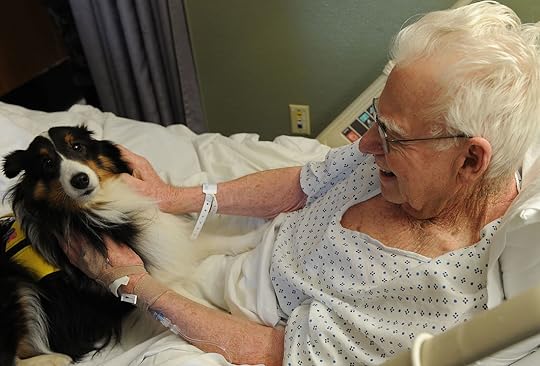
Published on October 04, 2017 08:43
September 26, 2017
animal heroes - heartstrings a'tuggin'!
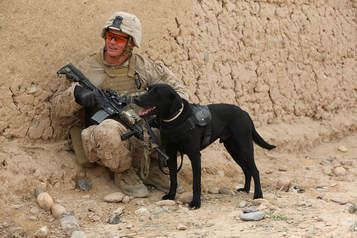 They conduct search and rescue. They serve in the military. They lead the blind and alert the hard-of-hearing. They comfort people in crisis, visit the hospitalized and those in hospice care; they even provide a soothing balm for us, their guardians. They survive abuse and neglect to become someone’s beloved pets. They are animal heroes!
They conduct search and rescue. They serve in the military. They lead the blind and alert the hard-of-hearing. They comfort people in crisis, visit the hospitalized and those in hospice care; they even provide a soothing balm for us, their guardians. They survive abuse and neglect to become someone’s beloved pets. They are animal heroes!Images of the dogs searching for the trapped and injured on 9/11 and during last week’s earthquake in Mexico resonate in our hearts and souls. From fires in homes and cresting ocean waves to hospital rooms and school bullying problems, dogs, cats, horses, guinea pigs and other animals provide rescue, comfort, security, and therapy to many humans, their own as well as strangers. From the military veteran suffering from PTSD or physical disability to the child lost in the woods or the trapped earthquake victim, animals respond to the needs of people as they fulfill their roles of service, comfort or search and rescue. They are K-9 officers protecting communities and military service dogs sniffing out bombs and bad guys.
Every fall, the American Humane Association partners with the Hallmark Channel to present The Hero Dog Awards. From a service dog named Roselle who guided her blind owner and others out of a building during 911 to an abused pit bull named Hooch, canines have been celebrated for their heroic story for more than five years – and their stories tug at the heartstrings!
This year’s Hero Dog Award winner’s story is no different. American Humane recently announced the 2017 winner: a one-eared pit bull named
Cats are also known to be heroes. Last year the BBC reported on several cat heroes, including one that detected cancer in her special human and another who came to the rescue of the young boys he lives with.
Hero animals – whether they do incredible feats of bravery or are simply the companions of the household, they all deserve to be called the Heroes of Our Hearts!
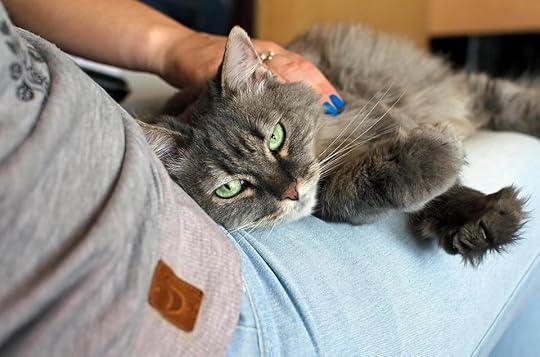
Published on September 26, 2017 05:30



